A History of the County of Hertford: Volume 3. Originally published by Victoria County History, London, 1912.
This free content was digitised by double rekeying. All rights reserved.
'Parishes: Hinxworth', in A History of the County of Hertford: Volume 3, ed. William Page( London, 1912), British History Online https://prod.british-history.ac.uk/vch/herts/vol3/pp232-240 [accessed 26 November 2024].
'Parishes: Hinxworth', in A History of the County of Hertford: Volume 3. Edited by William Page( London, 1912), British History Online, accessed November 26, 2024, https://prod.british-history.ac.uk/vch/herts/vol3/pp232-240.
"Parishes: Hinxworth". A History of the County of Hertford: Volume 3. Ed. William Page(London, 1912), , British History Online. Web. 26 November 2024. https://prod.british-history.ac.uk/vch/herts/vol3/pp232-240.
In this section
HINXWORTH
Haingesteworde, Hainsteworde, Hamsteworde (xi cent.); Hingslewurd (xii cent.); Hengsteworth, Hyngstrigge, Heynceworth (xiii cent.); Hangteworth, Hynxworth (xiv cent.); Hyggextworth, Hyngxtworth (xv cent.); Henxworth (xvi cent.).
The parish of Hinxworth is in the extreme north of the county on the borders of Cambridgeshire and Bedfordshire. It lies low, the ground nowhere rising more than 172 ft. above the ordnance datum. An ancient track called the Ridgeway crosses the low land on the east of the parish, running parallel with the River Rhee, which forms the north-east boundary. The area is 1,463 acres, of which nearly threequarters are arable land, and the remainder, except for some 8 acres of woodland, pasture. (fn. 1) The soil is loam and blue clay, the subsoil varies. The chief crops are wheat, barley and turnips. Coprolites have been dug in the parish and are still to be found. An Act authorizing the inclosure of the common fields was passed in 1802 and the award was made in 1806. (fn. 2)
The nearest railway station is Baldock, 5 miles to the south, on the Hitchin and Cambridge branch of the Great Northern railway.
The Roman road through Hertfordshire, known further east as Stane Street, skirts the parish on the west and forms its south-west boundary. Not far from this road, on the borders of Hinxworth and Caldecote, Roman remains were discovered about 1720 by some workmen who were digging there for gravel with which to repair the road. These included several human bodies, urns and paterae and other objects, and a Danish or Dutch coin. (fn. 3) In 1810 a further find of great interest was made in the parish of two rare Greek coins or medals, one of Mithridates King of Pontus, and the other of Perseus King of Macedonia, both very well preserved. (fn. 4) Near the River Rhee in the north of the parish and not far from the camp at Arbury Banks or Harboro, and near the Ridgeway, a hoard of more than 500 Roman coins was discovered. Near them were found other Roman remains. (fn. 5)
The village of Hinxworth lies a little more than a mile to the east of the Roman road, with which it is connected by roads leading north-west and southwest, the former being continued on to Ashwell. The church (fn. 6) and rectory stand on the south-east of the angle formed by the road to Ashwell and that leading south-west to the Roman road, and the small village lies a little to the north-west of the church. At the beginning of the 18th century it had only thirty-five houses, of which three were almshouses. (fn. 7)
Hinxworth Place, the manor-house, the residence of Mrs. Sale, stands about half a mile south of the village. (fn. 8) It consists of a rectangular block, measuring externally about 55 ft. by 38 ft., at the south end of which is a portion of a wing. The main block is faced externally with soft limestone, or clunch, and, judging from the characteristic features of the doorways and windows, a great part of the main walls must have been erected towards the close of the 15th century. The south wing appears to belong to the 16th century.
Beside the principal doorway is a small twolight window with arched and cusped heads, and square hood moulding over. This window is recessed from the face of the wall, and the sill is carried down so as to form a seat outside. The details of this window are almost identical with those of the low-side window in the south nave wall of the parish church. The principal entrance opens directly into the old hall, a room measuring about 21 ft. by 20 ft., now used as a kitchen. To the south of this is a smaller apartment used as a dining room, off which a passage has been cut to give access to the south wing from the kitchen. Between the kitchen and the dining room are two wide fireplaces placed back to back. Sixty years ago there were no partitions between the kitchen and the dining room, so that they formed practically one large room with the fireplaces in the centre. Each room is lighted by a large four-light early 17thcentury window, with moulded stone transoms and mullions and a small cornice over. In the kitchen is a long narrow Jacobean oak table with heavy moulded legs. Extending the whole length of the main building on the west side is a low one-story building, the north end of which is a later addition built of old material. It is covered by the roof of the main building, which is continued down so as to form a lean-to roof. There are three doorways in the separating wall, all having splayed jambs and fourcentred arches. There is a similar external doorway on the west side, and another now built up at the north end. There are two three-light windows, one four-light and one single-light window, with stone-moulded mullions and cusped-pointed archheads, similar to the window on the east front, and all late 15th-century work. This part of the house has been divided into scullery, larder and stores. The modern passage by the dining room leads to the south wing, the lower part of which is of brick, the upper story being of timber, overhanging 18 in. on the south and west fronts. It was originally one large room, with a four-centred stone doorway at the east end, similar to that from the dining room, but now there is a small lobby between the outer door and the old parlour. There is a built-up external doorway in the south wall, and a large five-light window, with moulded stone mullions and transoms, in the west wall. In this window are three interesting shields with the arms of former owners, one bearing the date 1570. The colour is on the surface of the glass only, or as it is called ' flashed,' such as was usual at that period, the older glass being stained right through. There is a good stone fireplace in the parlour, the details of which have a more classic feeling than the 17th-century work in the main building. The fireplace has moulded jambs and straight lintel, the mouldings being late Gothic in character. On either side is a short threequarter-round column with rude Ionic volutes, above which is a long rectangular fluted and panelled pilaster, supporting a moulded stone cornice or mantel shelf. Over the fireplace and under the cornice is a frieze with four plain sunk panels. There is a large room over the parlour, open to the roof, which is plastered internally, the only timber showing being a massive oak moulded tie-beam, with a considerable camber, a tree with a natural bend having evidently been utilized for the purpose. The upper floor in the main building contains some four-centred doorways of stone, in several of which the original iron studded door remains, and in the north bedroom is a stone fireplace of the usual early 17th-century type, with moulded four-centred arch inclosed by a square moulding above, and with the usual ornamental stops to the mouldings.
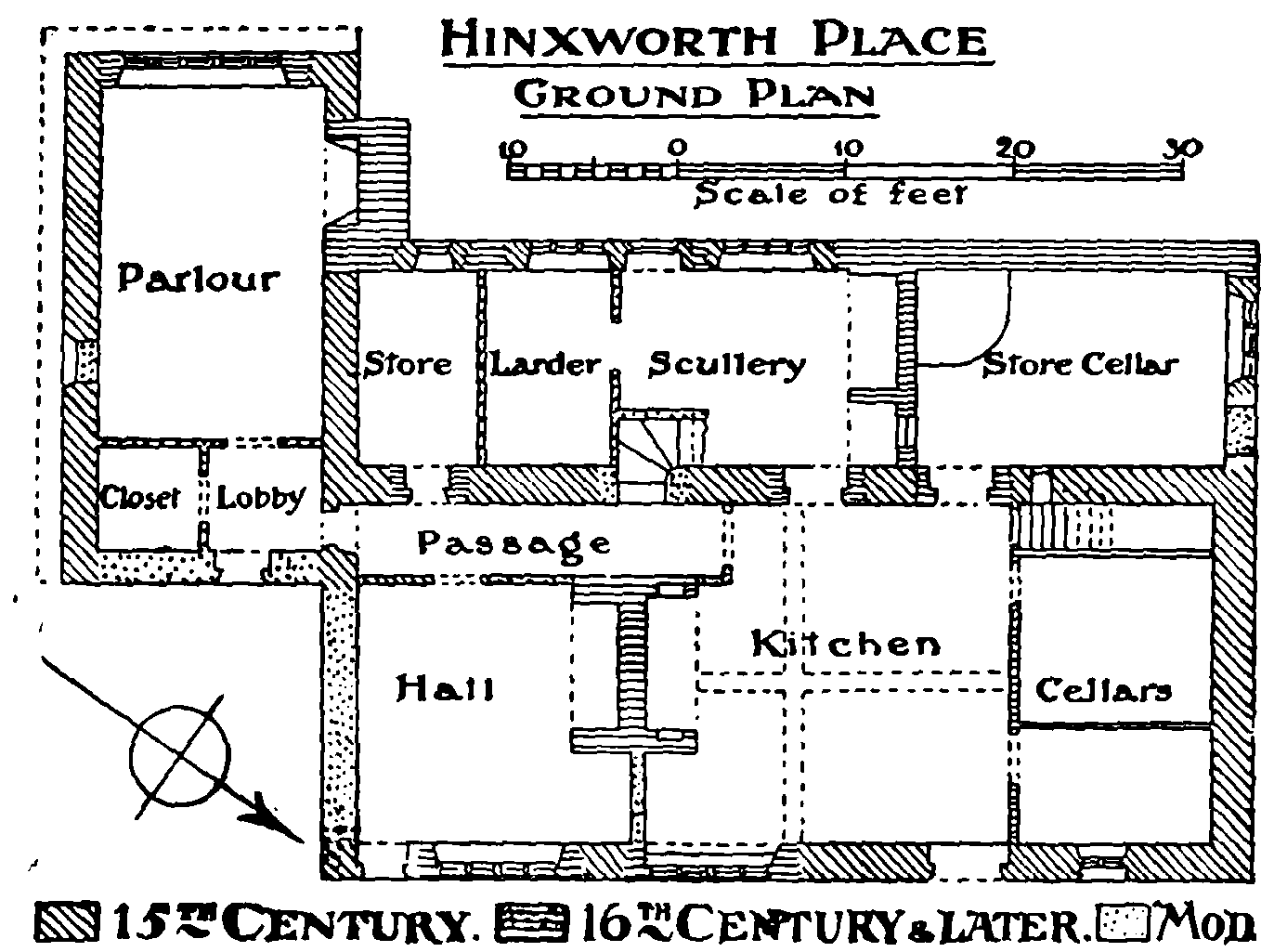
Hinxworth Place: Ground plan
There is no trace of any main stair having existed, access to the upper floor being by two narrow wooden ones. All the chimneys are of brick, and are plain modern rebuildings. The roofs are tiled. Preserved in the house are two large iron spring man-traps, and the original notice to beware of them may still be seen on one of the barns.
Bury End, which is situated nearly opposite the church, at the point where the Ridgeway joins the village street, is of interest, as it is partly surrounded by a fragment of a homestead moat. (fn. 9)
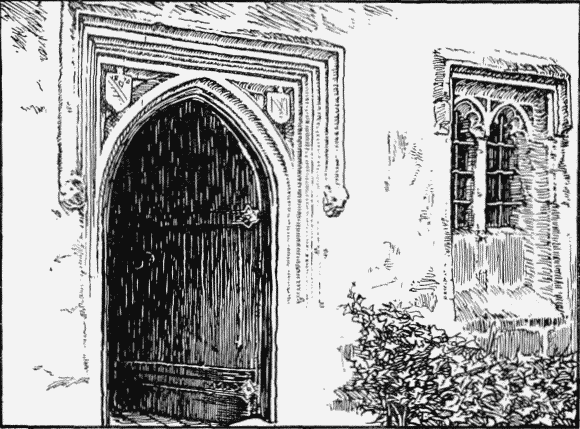
Hinxworth Place: Principal Entrance Doorway
There is a Wesleyan chapel in Hinxworth, which lies on the south side of the village. Its site was purchased in 1831 for £7 by public subscription among the Methodists. (fn. 10) The village school was built in 1876. It stands on the north side of the village street west of the church.
Among those who have held the living of Hinxworth may be noted the Rev. Percival Stockdale (1736–1811), who in 1756 accepted a commission in the army and was attached to the expedition sent by Admiral Byng to relieve the garrison of Minorca. He was ordained deacon in 1759, and coming to London became intimate with Johnson, Garrick, Goldsmith and other literary men. In 1779 he made a complaint, probably groundless, that the agreement to bring out the lives of the English poets had been originally entrusted to him. In 1780 he was presented by Sir Adam Gordon to the rectory of Hinxworth. (fn. 11)
MANORS
Hinxworth
In the time of Edward the Confessor (fn. 12) HINXWORTH was divided between Ethelmer of Benington and his tenants, the sokemen of the king, the archbishop and others. After the Conquest it was held by three tenants in chief, William de Ow, (fn. 13) Hardwin de Scales, (fn. 14) and Peter de Valognes. (fn. 15) Peter de Valognes's holding was a berewick of his holding at Ashwell, and the overlordship descended with his manor there (q.v.) until the death without issue of Christine de Mandeville Countess of Essex in 1233. Her lands in Ashwell seem to have reverted to Robert Fitz Walter, her brother, but the overlordship of her lands in Hinxworth appears to have remained with Maud, her husband's sister and heir, whose son Humphrey de Bohun was created Earl of Essex, (fn. 16) for in 1345 Humphrey de Bohun appears as overlord of a manor of Hinxworth which was held of him by Henry Gernet and Joan his wife. (fn. 17) These were the tenants also of Ashwell, with which manor Hinxworth had descended in sub-tenancy until this date, after which there is no further trace of it as a separate property.
Hardwin de Scales's lands were divided between his sons Richard and Hugh. Their descendants were still holding part of a knight's fee in Hinxworth in 1207–8 when William grandson of Richard de Scales claimed possession of the holding against Hugh grandson of Hugh. The suit was decided in favour of Hugh. (fn. 18) No further record of the Scales in Hinxworth appears. Theobald was tenant of this fee in 1086, and his descendants the Fitz Ralphs appear subsequently as holding a third of a fee. In 1303 this was held of William Fitz Ralph by Henry de Aula. (fn. 19) It descended to William de Aula, from whom it passed to William Zerde, who was holding it in 1428. (fn. 20) After this date the fee can be no further traced.
The land of William de Ow in Hinxworth (held under him in 1086 by two knights) was apparently granted with other estates by Henry I to Walter son of Richard de Clare, (fn. 21) on whose death they passed to his nephew Gilbert de Clare, (fn. 22) who was created Earl of Pembroke in 1138. (fn. 23) He was succeeded by his son Richard de Clare, (fn. 24) who died in 1176, when his estates passed to his daughter Isabel. (fn. 25) She married Sir William Marshal, created Earl of Pembroke, (fn. 26) and with her husband was holding land in Hinxworth in 1196. (fn. 27) William Marshal died in 1219, (fn. 28) and his estates passed in rapid succession through the hands of his five sons, all of whom died without issue. (fn. 29) On the death of the youngest, Anselm Marshal, (fn. 30) in 1245, their lands were divided among his five sisters and co-heirs. (fn. 31) The eldest of these, Maud, married Hugh le Bigod Earl of Norfolk, (fn. 32) and her grandson Roger (fn. 33) claimed view of frankpledge and assize of bread and ale in Hinxworth in 1277–8. (fn. 34) He died in 1306 (fn. 35) holding a quarter of a fee in Hinxworth. (fn. 36) In consequence of his having rebelled against the king his estates reverted to the Crown. (fn. 37) His land in Hinxworth was amongst the estates which the king granted in dower to his widow Alice. (fn. 38) In 1312 Thomas Plantagenet, fifth son of Edward I, was created Earl of Norfolk, and he received all the lands of the late earl. (fn. 39) He died in 1338 and his lands were divided between his two daughters and co-heirs. (fn. 40) The elder of these, Margaret, married Lord Segrave. (fn. 41) The younger, Alice, married Edward de Montague, and, with the consent of her sister Margaret and her husband, certain estates, including the fifth part of a fee which her father had held in Hinxworth, were assigned to her. (fn. 42) Her daughter Joan married William Ufford Earl of Suffolk. (fn. 43) She had no children and died in 1375. (fn. 44) Her husband died in 1382 seised of a fifth of a knight's fee in Hinxworth. (fn. 45) The second sister and co-heir of Anselm Marshal, Isabel, married Gilbert de Clare Earl of Gloucester and Hertford, (fn. 46) who was assessed for half a fee in Hinxworth in 1303, (fn. 47) and who died seised of it in 1314. (fn. 48) A third sister and co-heir of Anselm Marshal (fn. 49) who had rights in Hinxworth was Joan wife of Warin de Munchensy. Her title passed to her daughter Joan wife of William de Valence, created Earl of Pembroke. (fn. 50) Their son Aymer de Valence inherited a quarter of a knight's fee in Hinxworth, which he had alienated in 1303. (fn. 51) After this date the different holdings cannot be distinguished except by their under-tenants, who are numerous and not easy to trace, for the land seems to have been much divided up as it was before the Conquest.
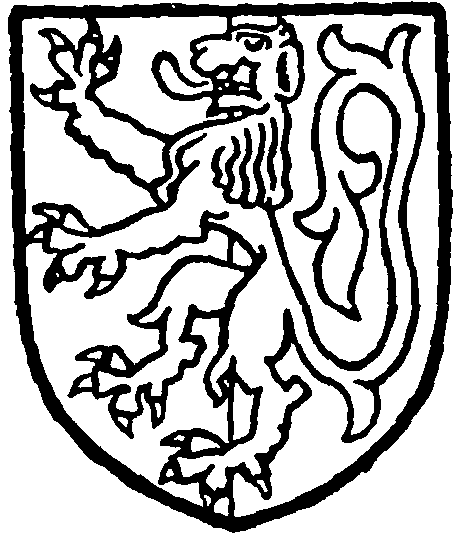
Marshal. Party or and vert a lion gules.
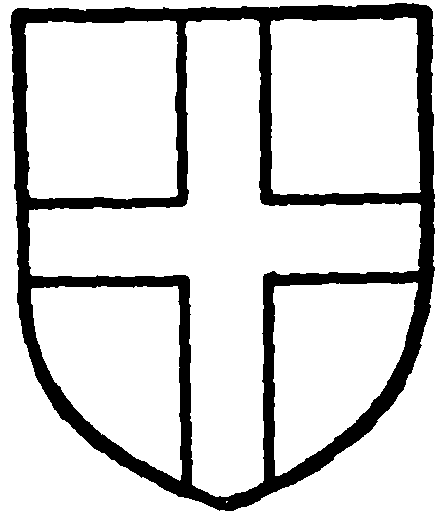
Bigod. Or a cross gules.
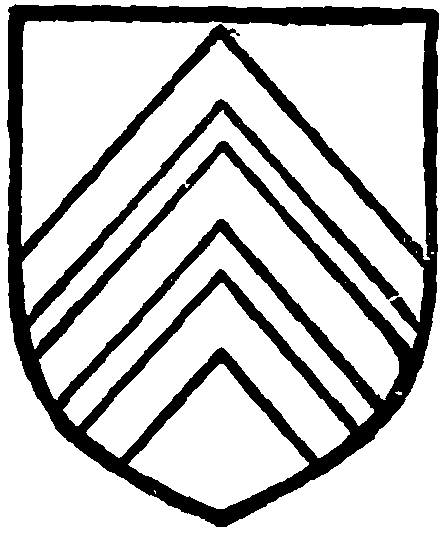
Clare. Or three cheverons gules.
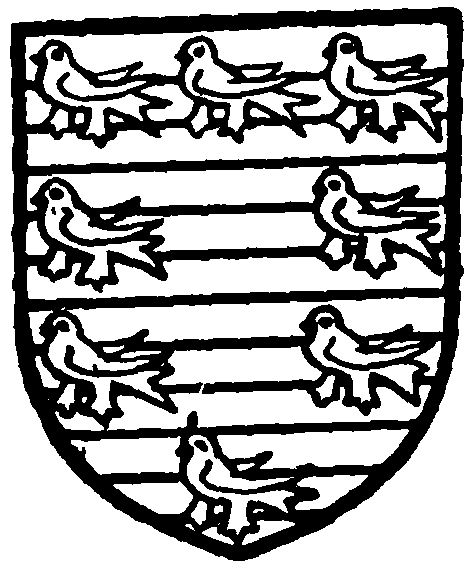
Valence. Burelly argent and azure an orle of martlets gules.
Under William Marshal a hide of land was held in 1196 by Eustace son of Airic Longi of Weston, and was in that year granted by him to Richard de Milkley. (fn. 52) In 1278 Robert de Milkley was summoned to show by what warrant he held view of frankpledge in Hinxworth, (fn. 53) but he withdrew his claim in favour of the overlord Roger Bigod. In 1287, however, he was said to hold this and other liberties in Hinxworth of the said Roger. (fn. 54) This fee is returned in 1306 (on the death of Roger Bigod) as held by Walter le Baud, (fn. 55) and Thomas le Baud was holding it in 1428. (fn. 56)
Another holding was that which in the 13th century was in the tenure of a family named Stopham. Ralph de Stopham and Milisent his wife claimed view of frankpledge and assize of bread and ale in Hinxworth in 1286–7. (fn. 57) This holding, described as a quarter of a knight's fee, was in the hands of Isabel de Stopham in 1303. (fn. 58) In 1428 it had become the property of Thomas Bryd, then a minor. (fn. 59) A Roger Brian also held lands and rents in Hinxworth in 1292, (fn. 60) in which year he granted 2 acres of land and 100s. rent to a chaplain in the chapel of St. John the Baptist at Buntingford, retaining other land there. This land, described as a quarter of a knight's fee, he was still holding in 1303. (fn. 61)
At the end of the 15th century these different holdings seem to have been amalgamated in the manor of HINXWORTH or WATTONBURY, which was then owned by Richard Waferer, who leased it in 1471–2 to John Ward, alderman of London. (fn. 62) It descended to Thomas Waferer of Sundridge, co. Kent, who in 1521 sold it to John Bowles of Wallington, co. Herts. (fn. 63) John Bowles died in 1543, (fn. 64) and the manor passed to his grandson Thomas Bowles, (fn. 65) who in 1556 sold it to William Hyde. (fn. 66) It was sold by William Hyde before 1571 to Jasper Smyth and Elizabeth his wife, for in that year they conveyed it to Thomas Norwood. (fn. 67) Thomas Norwood died in February 1587–8 and left the manor to Thomas Norwood, third son of his son John Norwood. (fn. 68) He in 1613–14 sold it to Thomas Draner of Hoxton, co. Middlesex. (fn. 69) Thomas Draner held the manor till his death in 1632. Having no children he left it by will to his cousin William Boteler for life with remainder in tail-male to his great-nephew Francis Halton (a younger son of Sir Roger Halton, son of Joan, Thomas Draner's sister) (fn. 70) with contingent remainder successively to his great-nephews Draner and Henry Massingberd, (fn. 71) the sons of Frances daughter of Joan, who had married Thomas Massingberd of Bratoft, co. Lincs. (fn. 72) Thomas Draner's nearest heir was his great-great-niece Elizabeth Halton, (fn. 73) then aged nine, who in 1665 with her second husband James Moseley (fn. 74) quitclaimed all right in the manor of Hinxworth. (fn. 75) William Boteler and Francis Halton, the first and second devisees, seem to have died without children, for the manor came to Sir Draner Massingberd, knighted in 1660–1, (fn. 76) and was held after his death by his widow. (fn. 77) On her death it descended to her son (fn. 78) Burrell Massingberd, who was holding the manor in 1705. (fn. 79) In 1709 he sold it to Sussex Sell of Hinxworth, (fn. 80) who with his wife Sarah sold it in 1711 to John Izard (fn. 81) of Baldock, draper. (fn. 82) By the will of John Izard dated 25 April 1713 and proved in August 1714, Hinxworth was left to his wife Ellen for life with remainder to his son Robert. (fn. 83) Robert Izard married Grace Cox in 1719 and had a daughter Grace who was seised of the manor on his death. In 1744 she married Thomas Daniel of Devizes, co. Wilts., but died childless a year later, when she left the manor to her husband. (fn. 84) John Izard (elder brother of Robert) quitclaimed all right in the manor to Thomas Daniel in 1754, (fn. 85) and the latter continued to hold it until 1766, when he sold it to Robert Thurgood of Baldock. (fn. 86) Sarah, daughter of the latter, married Thomas Clutterbuck, (fn. 87) and by her father's will dated 26 March 1774 (fn. 88) inherited the manor of Hinxworth. On her death in 1788, (fn. 89) by the terms of the will, (fn. 90) it descended to her son Robert Clutterbuck, the historian. He died in 1831 and was succeeded by his son Robert, (fn. 91) who died in 1879. (fn. 92) The manor was bought of his trustees by Mr. John Sale in 1881. He died in 1894, and the manor is now held by his trustees.
Cantlowbury
The manor of CANTLOWBURY (Cantilbury, Cantlebury, Cantlobury, xvi cent.) is not mentioned by name before 1521–2. (fn. 93) It probably took its name from the family of Cantlow or Cantelupe, who had land in Hinxworth as early as 1176, when Walter de Cantelupe held property there. (fn. 94) It seems probable that their lands in Hinxworth were not inconsiderable, for they owned the advowson of Hinxworth Church, (fn. 95) which continued with their descendants until 1346. (fn. 96) In spite of this no further record can be found of what land they held. The manor of Cantlowbury was held in 1522 by Thomas Waferer, (fn. 97) who also held the manor of Hinxworthbury alias Wattonbury (q.v.). From this date the two manors descend together. (fn. 98) The manor-house of Cantlowbury was for some time held by a family of the name of Harvey, but was pulled down about 1865. (fn. 99)
The priory of Newnham in Bedfordshire held lands in Hinxworth in the 13th century, and in 1278 the prior was summoned to show by what warrant he held view of frankpledge and assize of bread and ale there. The prior, however, withdrew all claim to these liberties. (fn. 100) His lands and rents in Hinxworth were valued in 1291 at £1 10s., (fn. 101) and described as a quarter of a knight's fee in 1303. (fn. 102) These lands remained with the priory until the 16th century, (fn. 103) and it is probable that on its dissolution by Henry VIII (fn. 104) they became absorbed in the manor of Hinxworth.
Pulters
The reputed manor of PULTERS (Polters, xviii cent.; Potters, xix cent.) seems to be first mentioned by name in the year 1782. Chauncy says that it was held in the reign of Edward IV by a family of the name of Pulter, who held it of the king for a yearly rent of 10s. 8d. (fn. 105) From them he says it was sold to John Ward, son of Richard Ward of Holden, co. York., who was Lord Mayor of London for one month in 1484. (fn. 106) The Wards appear to have been connected with Hinxworth as early as 1453, for Simon Ward, who died in that year, was buried in Hinxworth Church. (fn. 107) John Ward, who placed a window in Hinxworth Church, certainly held land in Hinxworth, for Chauncy says he gave cow commons to maintain the church in repair, the people of Hinxworth being taxed according to the number of cows they had on the common. (fn. 108) But there seems to be no direct proof that his lands were the manor of Pulters. Chauncy says that after the death of John Ward in 1487 his lands in Hinxworth were conveyed to John Lambard, master of the Mercers' Company and alderman of London. (fn. 109) John Lambert or Lambard was holding lands in Hinxworth of the manor of Hinxworth at the end of the 15th century, (fn. 110) but there is nothing to show that they represent the manor of Pulters. In the 16th century this holding had descended to Thomas Lambert, and included a capital messuage. (fn. 111) Chauncy says Thomas Lambert was charged in Exchequer for this manor by the name of Pulters with a yearly rent of 10s. 8d. (fn. 112)
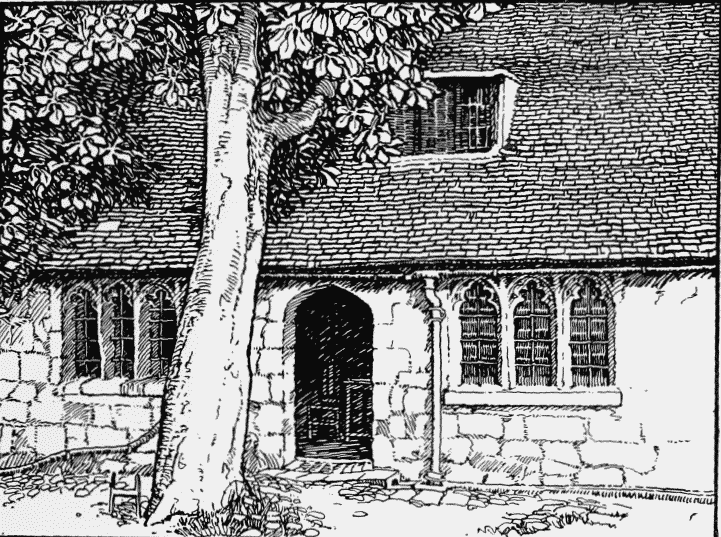
Hinxworth Place: Part of South-west front
According to some proceedings in the court of Chancery Thomas Lambert fell into financial difficulties. It appears that Andrew Gray of the Inner Temple promised to give him introductions which would lead to an advantageous marriage, (fn. 113) and in return Thomas Lambert granted him a lease of his lands in Hinxworth on very favourable terms. (fn. 114) He eventually mortgaged his property to Gray. (fn. 115) As a natural consequence he brought a suit against Gray (fn. 116) in which he said he had never received the introductions nor been enabled to make a good marriage. (fn. 117) The lands, however, were probably retained by Gray, (fn. 118) who died in 1614 and whose monument is in the parish church. From him they appear to have passed to Andrew Bayning, (fn. 119) who held, besides the advowson of Hinxworth, four messuages, two dove-houses, four gardens and four orchards, 489 acres of land and 10s. rent in Hinxworth, Caldecote and Ashwell. (fn. 120) These descended with the advowson (q.v.) until the latter was divided between the daughters of the first Viscount Bayning. Pulters was then sold to Edward Pecke, (fn. 121) from whom it descended to his son William Pecke, (fn. 122) whose son Edward Pecke was holding the manor in 1700. (fn. 123) It passed finally with the advowson to Richard Holden. (fn. 124) On his death it descended to his son Robert Holden, (fn. 125) and in 1782 was held by the latter's two daughters, Elizabeth wife of Richard Webb and Charlotte wife of Sir Adam Gordon. (fn. 126) It finally became the exclusive property of Elizabeth, (fn. 127) and she with her husband Richard Webb, her son Richard Holden Webb, and his wife Frances (fn. 128) sold it in 1801 to Henricus Octavus Roe, (fn. 129) apparently in trust for Robert Clutterbuck, (fn. 130) who held the manor of Hinxworth. In 1828 Robert Clutterbuck suffered a recovery of Pulters, (fn. 131) after which date it became merged in the manor of Hinxworth.
CHURCH
The church of ST. NICHOLAS consists of chancel 20 ft. by 16 ft., nave 42 ft. 6 in. by 20 ft., west tower 10 ft. 6 in. square, and south porch 12 ft. by 10 ft., all dimensions taken internally. The walls are of flint with stone dressings and the low-pitched roofs are covered with lead.
The general walling of nave and west tower, the north and south doorways and the windows adjoining them on the west, belong to the middle of the 14th century; the west window of the tower and the north, south and west belfry openings were inserted later in the century (fn. 132); the east belfry opening may be original. About 1440 the chancel arch was pulled down and built about 2 ft. further east, and the two large nave windows with their niches and the low-side window were inserted, and the upper passage to the rood-loft roughly formed eastward towards the new chancel arch. The clearstory was raised about the close of the 15th century and the south porch was erected, and the chancel arch recut to fit it under the new low-pitched roof, the former roof having been high-pitched, as shown by the marks on the cast face of the tower. The chancel was rebuilt of brick about the beginning of the 18th century. In 1887 the church was restored, a new roof put over the nave, and stone windows inserted in the chancel. The nave and tower walls are embattled.
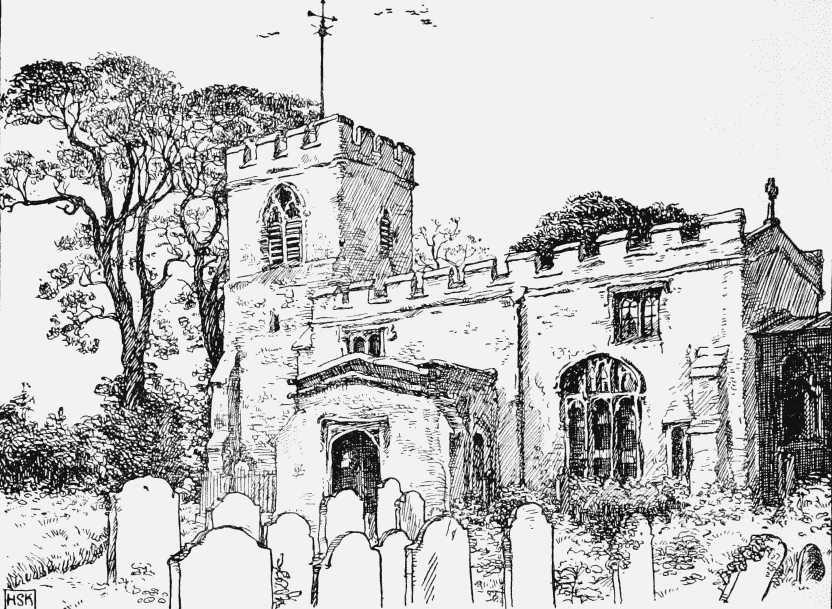
Hinxworth Church from the South-east
At the north-east angle of the nave externally the 14th-century external angle of the nave wall may be seen; the recess adjoining it, which is corbelled over above, shows the 15th-century extension of the nave eastward. At the north-east part of the nave internally is the entrance doorway to the rood-loft stair, which projects on the outer face of the wall; it is of 14th-century work, but the original upper doorway is blocked, and a rough passage tunnelled through the wall eastward to reach the 15th-century chancel arch; some 14th-century moulded stones have been used in its construction; the rough state of the north and south walls of the nave shows the old position of the chancel arch. In the north wall of the nave is a large 15th-century three-light window with tracery in the head under a four-centred arch; in the east jamb is a canopied niche with carved crockets and finials and cusped pedestal. In the south wall is a similar window, and to the east of it is a low-side window of two cinquefoiled lights under a square head, of the same date as the larger windows; in the south-east angle of the nave is a canopied niche very similar to that on the north side; both niches have traces of colour. The north door is of 14th-century date, of two hollow-chamfered orders, but the label has been cut off. The south doorway is similar to the north. Both doorways retain their original oak doors, with plain iron hinges; the south doorway has deep sockets in the jambs for the oak bar. The floor of the nave is about 2 ft. lower than the ground outside. To the west of the north doorway is a 14th-century two-light window, cusped and under a square head. The label has the wave moulding. The opposite window in the south wall of the nave was a similar two-light window, but one light has been blocked by the south porch, and the remaining light widened by the insertion of a keystone in the apex of the arch. The nave roof is modern, but contains four figures of monks holding shields, from the old roof; three of the shields are plain, the fourth is barred.
The south porch is of late 15th-century work; on the west side is a three-light window, with trefoiled cusps, under a four-centred head: a similar window on the east side has been blocked. The entrance doorway has a moulded four-centred arch under a square head.
The tower arch, c. 1350, is of two splayed orders, with semi-octagonal jambs and moulded capitals and bases; the west window is an insertion of the latter part of the century, and is of two cusped lights with a large cusped opening in the head; it has been repaired with cement. Underneath the window a rough doorway has been cut in comparatively recent times. The tower, which has no stairway, is of two stages, with embattled top, with moulded stringcourse under, at the angles of which are carvings, that at the south-west representing a soldier's head armed with basinet and camail of the 14th century. In the north, south and west faces of the belfry stage are two-light cusped openings, similar in character to the west window and of late 14th-century work. On the east face is a small trefoil-headed opening, above the apex of the old steep roof, which is probably original.
The font is modern, but the remains of the old one, consisting of a circular basin with a plain square top, lie in the garden of the Glebe Farm. It appears to be of the late 12th century. The communion table is of Italian workmanship, with claw feet on balls and a marble top. The pulpit is of plain panelled oak of the 18th century.
In the porch is a portion of a stone coffin lid, with the lower part of a cross, and the ends of scrolls, probably of late 13th or early 14th-century work.
On the north wall of the chancel is a brass of a man and his wife; the inscription has gone, but is given by Chauncy as being the figures of Simon Ward, 1453, and his wife, 1481; the slab from which this brass was taken lies at the north doorway. On the chancel floor is a brass of a man with his wife and children, one of whom is a priest. According to Chauncy this brass represents John Lambert, citizen and mercer of London, who died in 1487. There are some shields; one bears the arms of the Mercers' Company, another a merchant's mark; these are of brass, but there are three of lead, one of which bears a saltire; the other two bear a fesse between three defaced animals, probably lambs, as a punning coat of Lambert. There is a brass inscription to 'Andrewe Grey,' who died in 1614.
There are six bells: the treble by Mears & Stainbank, 1908; second by J. Briant, 1820; third and fourth by Miles Graye, 1651; fifth and tenor by J. Briant, 1825 and 1820 respectively.
The communion plate consists of cup and paten, 1762, and two pewter plates.
The registers are in two books: (i) baptisms and burials 1739 to 1812; (ii) marriages 1754 to 1812.
ADVOWSON
The advowson of the church was held in the 13th century by the Cantlowes. William de Cantlowe presented in 1218 and 1236 (fn. 133); he died in 1238–9 (fn. 134) and was succeeded by his son William, who died in 1250–1. (fn. 135) He was succeeded by his son, also named William, who died in 1253–4. (fn. 136) During the minority of the latter's heir George (fn. 137) the right of presentation was exercised by the king in 1273. (fn. 138) George was still living in May 1273, (fn. 139) but died some time before February 1274, (fn. 140) and his lands were divided between his two sisters, Millicent, who married first John de Montalt and secondly Eudo la Zouch of Harringworth, and Joan, who married John de Hastings. (fn. 141) The advowson of Hinxworth was inherited by the elder sister Millicent, who as Millicent de Montalt presented in 1293 and 1295. (fn. 142) It descended to her son by her second marriage, William la Zouch, (fn. 143) who presented in 1303. (fn. 144) He in 1344 alienated the advowson to the Abbot and convent of Pipewell, co. Northants, (fn. 145) perhaps on account of their poverty, for in 1322 the monks had been so poor that they had been obliged to leave their abbey for a time. (fn. 146) The advowson was held by the Abbot and convent of Pipewell (who do not seem to have appropriated the church) until their dissolution in 1538–9, (fn. 147) after which in 1545 the advowson of the rectory was granted to Anthony Forster. (fn. 148) From Forster it passed to John Brockett, who in February 1561–2 granted the next presentation to John Adams, but on his presenting refused to admit his nominee. (fn. 149) Brockett probably conveyed to Andrew Bayning (fn. 150) of Mark Lane, London, who died seised in 1610 and left it to his brother Paul Bayning for life with remainder to his son Paul Bayning the younger. (fn. 151) Paul Bayning died in 1616, (fn. 152) and the advowson passed to his son Paul, (fn. 153) who married Anne daughter of Sir Henry Glenham (afterwards Viscountess Dorchester), (fn. 154) and who in March 1627–8 was created Viscount Bayning of Sudbury. (fn. 155) He died in 1629 and his son Paul being a minor (fn. 156) the king presented in 1636. (fn. 157) The Viscountess Dorchester, however, opposed the king's right to present, (fn. 158) and in consequence the Bishop of Lincoln refused to admit the king's nominee, Dr. Andrew Clare. (fn. 159) A three years' lawsuit followed, (fn. 160) during the course of which Paul Viscount Bayning died in 1638, (fn. 161) and the king as guardian of his two daughters and co-heirs Anne and Penelope, who were minors, appointed Robert Cheslen on the resignation of Dr. Clare. (fn. 162) The Viscountess Dorchester died in February 1638–9 (fn. 163) before the close of the suit, but in 1639 judgement was given in her favour, (fn. 164) and the Bishop of Lincoln being suspended at that date, a writ was addressed to Archbishop Laud to admit her nominee, Daniel Falkner. (fn. 165) The archbishop at first refused to admit Falkner on the ground that he must take care of the king's title, (fn. 166) but admitted him finally. This reluctance was one of the matters brought against him in his trial in February 1640–1. (fn. 167) Anne and Penelope Bayning both died without issue, Penelope in 1657, Anne in 1659. (fn. 168) Anne's husband, the Earl of Oxford, (fn. 169) presented in 1660. (fn. 170) The advowson then reverted to the heirs of Paul first Viscount Bayning, and was divided among the descendants of his four daughters, Cecily, Anne; Mary and Elizabeth. (fn. 171) Cecily married Henry Pierrepont Marquess of Dorchester, (fn. 172) and their daughter Anne married in 1658 John Manners, styled Lord Roos, from whom she was divorced in 1666, (fn. 173) and married secondly John Tildesley. In 1674 she was holding an eighth part of the advowson. (fn. 174) William Pierrepont, evidently her heir, suffered a recovery of it in 1703. (fn. 175) The second daughter Anne married Henry Murray, (fn. 176) whilst the third daughter Mary seems to be represented in 1661 by Arthur Gorges and Mary his wife. (fn. 177) They sold all right in the advowson to Edward Pecke in 1664. (fn. 178) Mary the daughter and co-heir of Anne and Henry Murray married Sir Roger Bradshaigh, bart., (fn. 179) and her son Sir Roger Bradshaigh in 1697 conveyed to his father-in-law Sir John Guise (fn. 180) his mother's share in the advowson of Hinxworth. (fn. 181) The fourth and youngest daughter of Paul Viscount Bayning, Elizabeth, married Francis Lennard Lord Dacre, (fn. 182) and her son Thomas Lennard, who was created Earl of Sussex in 1674, (fn. 183) suffered a recovery of it in 1704. (fn. 184) The whole of the advowson seems to have been acquired by Richard Holden (see Pullers), who presented in 1727. (fn. 185) On his death it descended to his son Robert, who presented in 1739 and 1777. (fn. 186) Robert Holden left two daughters and co-heirs, Charlotte and Elizabeth; Charlotte married the Rev. Sir Adam Gordon and sold her share in the advowson to the Rev. Thomas Whitehurst in 1785. (fn. 187) Elizabeth married Richard Webb (fn. 188) and sold her share in the advowson also to the Rev. Thomas Whitehurst in 1787. (fn. 189) Thomas Whitehurst held the whole of the advowson till 1791, when he sold it to William Parkins, (fn. 190) possibly in trust for Richard Parkins, who presented in 1795. (fn. 191) In 1797 Robert Albion Cox presented. (fn. 192) By 1822 the advowson had come into the hands of John Lafont, (fn. 193) the rector of Hinxworth, who held it till his death, which took place between 1840 and 1844. It was held by his trustees until 1892, when it came into the possession of the Bishop of St. Albans, in whom it is still vested.
Meeting-places for Protestant Dissenters in Hinxworth were registered in 1763 and 1823. (fn. 194)
CHARITIES
In 1797 Jane Brooks, by her will proved in the Archdeaconry Court of Huntingdon 24 January, gave £160, the interest to be distributed equally among the poor of Hinxworth, Baldock, Biggleswade, and Stotfold. The property now consists of 7 a. 3 r. 18 p. of land at Stocking Pelham, in the county of Hertford, and the churchwardens receive one-quarter of the rent, amounting to £1 2s., which is distributed in bread on Good Friday and at Christmas.
The Wesleyan Methodist chapel comprised in deed of 1831 is regulated by a scheme of the Charity Commissioners of 1882.
